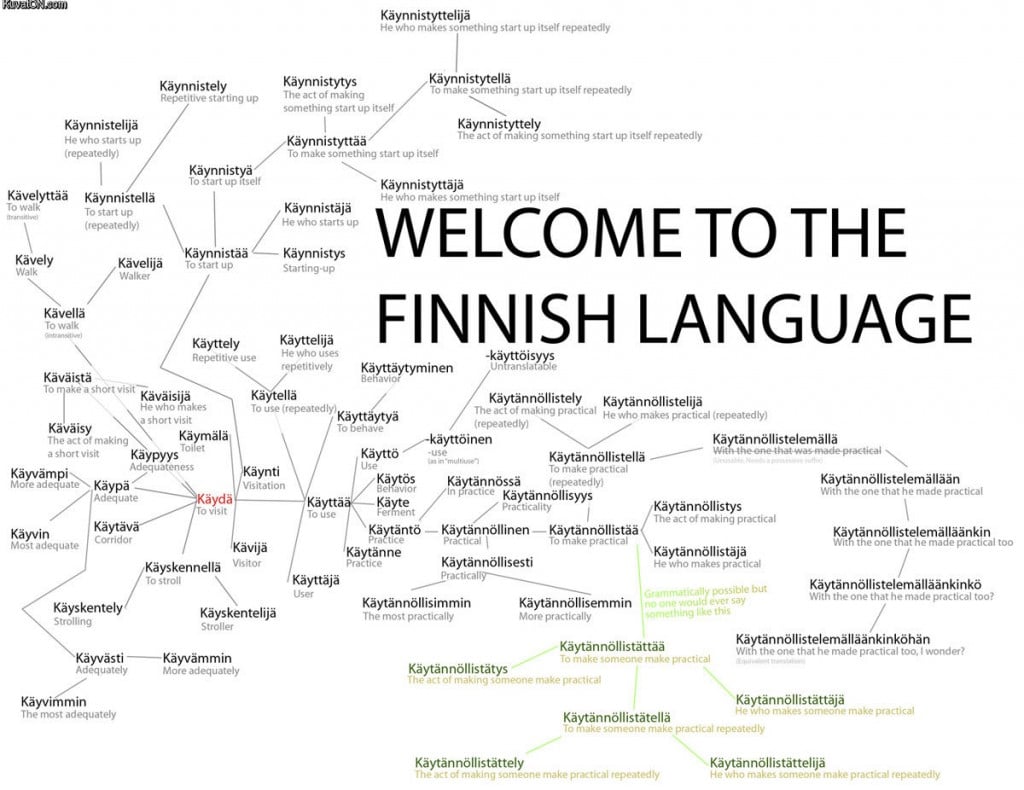The Building Blocks of the Finnish Language
Table of Contents
Please click the infographic for a larger version
Finnish is not difficult to learn, but it is certainly different from what English speakers are used to.
“Welcome to the Finnish Language” is an infographic that gives us a good picture of how words are constructed in Finnish. The branches start with a single word and then, as the ending is replaced and pieces continue to be added, the word has become thoughts, phrases and whole sentences.
Background of Finnish
Finland is the only area that has Finnish as its primary language. But Finnish belongs to a collection of languages called the Finno-Ugrian group. These include languages that are spoken across the region stretching from Norway to Siberia and to the Carpathian Mountains.
Other languages in this particular group include Estonian and Hungarian. Finnish is actually one of the more recent languages, only becoming established during the 1500s. And the language continues to evolve. In fact, today’s Modern Standard Finnish came out of a nationalist movement during the 19th Century.
Why Are the Words So Long?
The lengths of the words, some being extremely long in relation to English, stand out when observing the infographic. It turns out those long words can be translated into phrases of different grammatical functions and meanings, even whole sentences.
Inflections are added onto root words in Finnish to show grammatical functions. For example, Kaynnistaa means “to start up” and there are three words branching off from this one word to construct further meanings.
Kaynnistella means to start up repeatedly, Kaynnestya, “to start up itself,” and Kaynnistys, “is starting up.” There are 15 such declensional cases in Finnish. For comparison’s sake, English has only two: nominative, genitive.
Furthermore, when Kaynnistaa becomes Kaynnistyttaa, its meaning becomes “to make something start up itself.” In Finnish, single words can go on for an indefinite length. By adding endings and inflections you build what you want to say all in one word.
In English, on the other hand, separate words are used to construct sentences and complete thoughts.
How Difficult Is Learning Finnish?
Looking at the infographic, we can see that Finnish looks rather complicated and somewhat intriguing. In reality, just like any language, it takes practice speaking, repeating and listening to build a solid comprehension.
Finnish is logical and methodical, however. Once you understand the basic conjugation of verbs and how to use the endings and inflections, you’ll have a good grammatical foundation for learning the language. Then, as you learn basic words, it becomes easier to derive other words and expressions from there.
One example of how vocabulary words expand upon themselves is the word for book, Kirja. Using Finnish standard endings gives you Kirjasto for “library” or Kirjain for “letter” or “character.”
The infographic clearly demonstrates that it’s as easy as learning basic words and the inflections used as building blocks for communication in Finnish--however easy that is for you.



